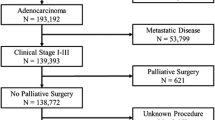Abstract
Background
Over the past 5 years, several studies have demonstrated that laparoscopic colon resection is an acceptable and perhaps preferable alternative to open resection for both benign diseases and cancer. The extent to which laparoscopic colon resections are used nationally is not known.
Methods
The Nationwide Inpatient Sample was used to identify laparoscopic and open elective colon resections performed in the United States each year from 2000 through 2004. The trends in adoption of the laparoscopic technique for each type of colon resection and for the most common diagnoses were identified, and differences in patient and provider characteristics were examined.
Results
From 2000 to 2004, the proportion of colon resections performed laparoscopically increased from 3% to 6.5%. The proportion performed for cancer increased from 1.4% to 4.3%, and for benign disease from 4.6% to 8.2%. Patients treated laparoscopically tended to be younger (median age, 61 years vs 66 years; p < 0.001) and to have fewer comorbidities (Charlson score of zero for 58.1% vs 37%; p < 0.001). Laparoscopic colon resections were more widely adopted in teaching versus nonteaching hospitals (5.1% vs 3.7%; p < 0.001) and in urban versus rural hospitals (4.7% vs 2.2%; p < 0.001).
Conclusion
Although the proportion of colon resections performed laparoscopically increased in the first half of this decade, it has remained very low. This trend is similar across procedure types and diagnoses. It remains to be seen whether greater patient demand and more recent trials will result in wider adoption of the laparoscopic approach.



Similar content being viewed by others
Explore related subjects
Discover the latest articles and news from researchers in related subjects, suggested using machine learning.References
Jacobs M, Vereja J, Goldstein H (1991) Minimally invasive colon resection. Surg Laparosc Endosc Percutan Tech 1:144–150
Martel G, Boushey RP (2006) Laparoscopic colon surgery: past, present and future. Surg Clin North Am 86:867–897
Alexander R, Jaques B, Mitchell K (1993) Laparoscopic-assisted colectomy and wound recurrence. Lancet 341:249–250
Milsom JW, Bohm B, Hammerhofer KA, Fazio V, Steiger E, Elson P (1998) A prospective, randomized trial comparing laparoscopic versus conventional techniques in colorectal cancer surgery: a preliminary report. J Am Coll Surg 187:46–57
Braga M, Vignali A, Gianotti L, Zuliani W, Radaelli G, Gruarin P, Dellabona P, Di Carlo V (2002) Laparoscopic versus open colorectal surgery: a randomized trial on short-term outcome. Ann Surg 236:759–767
Lacy AM, Garcia-Valdecasas JC, Delgado S, Castells A, Taura P, Pique JM, Visa J (2002) Laparoscopy-assisted colectomy versus open colectomy for treatment of non-metastatic colon cancer: a randomized trial. Lancet 359:2224–2229
The Clinical Outcomes of Surgical Therapy Study Group (2004) A comparison of laparoscopically assisted and open colectomy for colon cancer. N Eng J Med 350:2050–2059
Leung KL, Kwok SP, Lam SW, Lee JF, Yiu RY, Ng SS, Lai PB, Lau WY (2004) Laparoscopic resection of rectosigmoid carcinoma: prospective randomized trial. Lancet 363:1187–1192
COLOR study group. (2005) Laparoscopic surgery versus open surgery for colon cancer: short-term outcomes of a randomized trial. Lancet Oncol 6:477–484
Guillou PJ, Quirke P, Thorpe H, Walker J, Jayne DG, Smith AM, Heath RM, Brown JM, MRC CLASICC trial group (2005) Short-term end points of conventional versus laparoscopic assisted surgery in patients with colorectal cancer (MRC CLASICC trial): multicentre, randomized controlled trial. Lancet 365:1718–1726
Nationwide Inpatient Sample. Retrieved October 24, 2007 at http://www.hcup-us.ahrq.gov/nisoverview.jsp
Romano PS, Roos LL, Jollis JG (1993) Adapting a clinical comorbidity index for use with ICD9-CM administrative data: differing perspectives. J Clin Epidemiol 46:1075–1079
Washington, Wyoming, Alaska, Montana, and Idaho Rural Health Research Center (2006) The use of RUCAs in health care Seattle, WA: Retrieved January 24, 2007 at http://www.fammed.washington.edu/wwamirhrc/rucas/use_healthcare.html
Kemp JA, Zuckerman RS, Finlayson SR (2008) Trends in adoption of laparoscopic cholecystectomy in rural vs urban hospitals. J Am Coll Surg 206:28–32
Finlayson SR, Laycock WS, Birkmeyer JD (2003) National trends in utilization and outcomes of antireflux surgery. Surg Endosc 17:864–867
Schlachta CM, Mamazza J, Seshadri PA, Cadeddu M, Gregoire R, Poulin EC (2001) Defining a learning curve for laparoscopic colorectal resections. Dis Colon Rectum 44:217–222
Tekkis P, Senaagore AJ, Delaney CP, Fazio VW (2005) Evaluation of the learning curve in laparoscopic colorectal surgery: comparison of right-sided and left-sided resections. Ann Surg 242:83–91
Kincler S, Koller MT, Steurer J, Bachmann LM, Christen D, Buchmann P (2003) Multidimensional analysis of learning curves in laparoscopic sigmoid resection: eight-year results. Dis Colon Rectum 46:1371–1378
Guller U, Jain N, Hervey S, Purves H, Pietrobon R (2003) Laparoscopic vs open colectomy: outcomes comparison based on large nationwide databases. Arch Surg 138:1179–1186
Author information
Authors and Affiliations
Corresponding author
Rights and permissions
About this article
Cite this article
Kemp, J.A., Finlayson, S.R.G. Nationwide trends in laparoscopic colectomy from 2000 to 2004. Surg Endosc 22, 1181–1187 (2008). https://doi.org/10.1007/s00464-007-9732-8
Received:
Revised:
Accepted:
Published:
Issue Date:
DOI: https://doi.org/10.1007/s00464-007-9732-8




